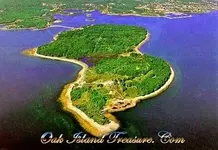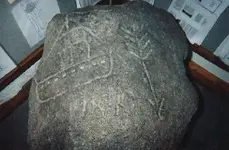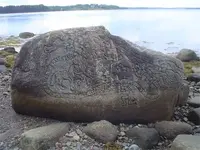Dave, Answer just a couple of questions and I want you to think hard, this go for Don Jose de La Mancha to. 1) Is there a posibility that Harold Willkins modified a version of a map that he had seen in the British museum? 2) Could people from different cultures have came together in the late 14th century? 3) Was it posible to keep a secret society after the 12th century? 4) Could have a group of people have searched for a land where there was no monarchy during that time? 5) Is it posible for a person to chissel a picture on a rock with no true "Artistic" tallent and have it resemble a boat? 6) How many men and how long would it take to complete what you already know about Oak Island. 7) Would the weathering of a stone be the same as above the water line as below? 8) is it posible for legends to contain some truth? 9) Is it posible for man to utilize artistic medians for purposes of other than Ornamental or personal expression? 10) What is "Artworks" basic use? 11) Does Oak Island have about the same shape as the Map? 12) Why does the discription on the Wilkins map match the man made and natural points of oak island, and remember that two of these points were not found until after the book was wrote.
1. Almost anything is possible, so yes. Of course, to consider this possibility would require accepting that the map is incorrect and would therefore be of questionable value.
2. This depends on which cultures we're discussing. As a general answer in the absence of further clarifying information, yes.
3. That's quite an open-ended question, so I'll take it at face value: theoretically, yes. To keep things in perspective, it would be theoretically possible for a person to build an internal combustion engine or an electric light bulb in the late 14th century, but this didn't happen until much later.
4. Yes. Depending on who the people were, they might have even known of such a place and how to get there.
5. Definitely, although one must wonder why someone with so little ability was entrusted with making a picture as important as you believe it to be - particularly when they had a guy that could do something like the other rock. Also, what's the number below the ship? It looks like "184".
6. Without more information, it's impossible to make such an estimate. Tell me how many men are available, what their skill breakdown is by trades, how many (if any) draft animals are available, and what tools and raw materials they brought with them, and I'll take a crack at it. Taking a guess without all of this information is simply that...taking a guess, and not even an educated one.
7. Unless the exposure began fairly recently, no.
8. Yes.
9. Ever seen a billboard advertisement? Of course.
10. Practically or philosophically? This is not a question that can be answered both accurately and briefly. If I had to try to accomplish both, I would say that the purpose of art is to convey ideas, stories, emotions, or any combination thereof.
11. Inasmuch as a corn flake does, yes.
12. Which parts match? The mountain range? The coral reef? The palm trees? The differences are much more numerous than any similarities. Honestly, the only similarity that I'm able to see is the general shape of the island, and it's only superficial. As I've already pointed out, even that is wrong.
I'm not sure what you're attempting to establish with these questions. Most of the specifics of your theories are technically possible, but more or less improbable. When a bunch of improbable ideas are combined to form a theory, this does not automatically legitimize all of them. Instead, it tends to amplify the error. I can accept a theory consisting of one garbage idea and nine good ones, but a theory based on eleven different improbable ideas tells me that the theory needs to be rewritten. This is all the more difficult in the case of Oak Island, as there are very few established and unquestionable facts to start with. Nearly every "fact" involved with the story can be shown to be inaccurate or even probably fabricated when one tracks them back to the beginning.
You mentioned that the map shares some similarities with Oak Island. So does the city of Bremerton, WA. We have a Smith's Cove for one thing. It doesn't mean that Bremerton is in any way connected to anyplace in Nova Scotia though. A few similarities do not make for a match, particularly when everything else is so far wrong. What are the other shared traits, and how do they stack up against the many dissimilarities that have already been mentioned?




 Just trying to 'help' since I have all that I can handle down here.
Just trying to 'help' since I have all that I can handle down here.